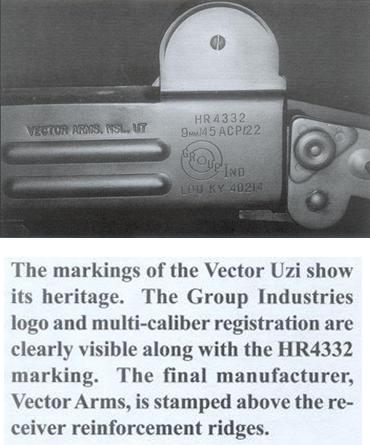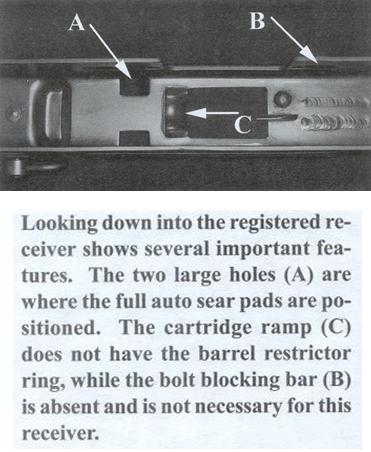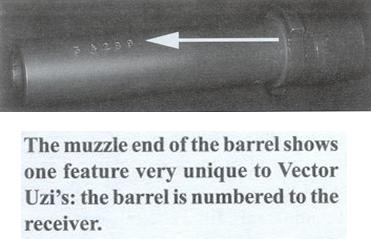
Vector UZI
 |
Vector UZI |
Let's see how Vector Arms does it.
 As
the heart of the Vector UZI, the raw receiver is CNC machined in several areas
to bring it into proper specification. Group Industries initially stamped them
slightly oversize, therefore, the front and back are slightly shortened while
the top is milled down a bit to reduce the receiver's height. Also, the distance
between the front/rear sight ears is adjusted to permit proper fitting of the
top cover. These operations are all done on a CNC mill which is equipped with a
special anti-vibration fixture. Once completed, all edges are debarred via
stoning.
As
the heart of the Vector UZI, the raw receiver is CNC machined in several areas
to bring it into proper specification. Group Industries initially stamped them
slightly oversize, therefore, the front and back are slightly shortened while
the top is milled down a bit to reduce the receiver's height. Also, the distance
between the front/rear sight ears is adjusted to permit proper fitting of the
top cover. These operations are all done on a CNC mill which is equipped with a
special anti-vibration fixture. Once completed, all edges are debarred via
stoning.
With the receiver now in tolerance, it is time for welding. The bayonet lug, foregrip and pistol grip lugs, barrel trunnion, barrel nut catch housing and butt plate are all TIG welded into position while using special holding fixtures to assure correct placement and 3 axis alignment. Once completed and passing inspection, the front and rear sight brackets are then fixtured in place and spot welded.
With this work completed, it
is time for another inspection followed by extensive weld grinding and polishing
to bring the entire receiver up to commercial standard. No jagged edges, globs
of weld, non-square comers, etc. All are brought up to the highest standard
possible. Then, the front and rear sight holes are drilled out on a press and
tapped with the appropriate threads. The final work on the receiver, before the
first grit blasting and heat treating, is the riveting of the sling swivel to
the left side. This is done via a special support fixture and pneumatic riveting
equipment. Now, time for case hardening.
The Group Industries receiver
is unique among all those produced by IMI, FN, Lyttleton or RH-ALAN: it is case
hardened. When a typical UZI is used over a very long period of time the rails
on the bottom of the bolt may wear longitudinal grooves into the receiver. This
can lead to incorrect stripping/chambering of the cartridge, alteration of sear
release geometry, etc. Mind you, we are talking about a lot of firing being done
to achieve these grooves, but, it can happen. As the receiver is the registered
part, Vector wanted to make sure it would not wear out. The bolt can be
replaced, not so the receiver.
 To
harden the Vector receiver via a carburizing process, it is first placed in a
special oxygen-free oven at 1500F and then exposed for four hours to carbon gas.
This penetrates the metal surface to a depth of .015". Then, it is quenched in
oil to bring the receiver hardness towards 60C on the Rockwell scale. As this is
too brittle, it is then tempered to bring the hardness down to the acceptable
range of 35C. By doing so the skin of the receiver is hard (resists wear) while
the interior is relatively soft (absorbs shock). Even though normal UZI
receivers are noted for their toughness, this receiver is simply not going to
wear out.
To
harden the Vector receiver via a carburizing process, it is first placed in a
special oxygen-free oven at 1500F and then exposed for four hours to carbon gas.
This penetrates the metal surface to a depth of .015". Then, it is quenched in
oil to bring the receiver hardness towards 60C on the Rockwell scale. As this is
too brittle, it is then tempered to bring the hardness down to the acceptable
range of 35C. By doing so the skin of the receiver is hard (resists wear) while
the interior is relatively soft (absorbs shock). Even though normal UZI
receivers are noted for their toughness, this receiver is simply not going to
wear out.
A little known fact is that the UZI ejector is also heat treated. The Vector UZI ejector is of a higher Rockwell number than the receiver, therefore it is pneumatically riveted in place after the receiver is hardened. Once this is done, it is time for finishing.
The parkerized finish of the
Vector is first class and bears special examination. After grit blasting the UZI
receiver/parts with #80 aluminum oxide grit to remove hardening scale (receiver)
and existing finish (the parts), it is then dipped in a low flashpoint Stoddard
solvent cleaning tank to ensure all grit dust and contaminants are removed.
Next, it is transferred to the Parco Lubrite #2 parkerizing tank and immersed
for 15 minutes at 205F. When removed, the acid is neutralized via dipping into a
hot water wash tank; when brought out of this tank the heated metal rapidly air
dries itself. Finally, everything is dipped into a tank of light oil so the
parkerizing's crystalline structure will readily absorb the petroleum and
provide the necessary protective surface.
The final step in production is to carefully assemble all the parts into a Vector UZI, gauge/examine it for fit of parts, smoothness of action, etc. Firing tests are done by doing a full magazine dump; particular observation being paid to the functioning of the first and last rounds as this is where the greatest malfunction chance occurs. Upon passing these tests it is then cleaned up and boxed into inventory.
Evaluation of the Vector UZI
The Vector UZI is an UZI....there is nothing new or unique about it since the 1MI version first emerged in 1951. It fires from the open bolt, while cyclic operation is based on the blowback principle. As it is a select fire weapon, the safety lever located by the right thumb of the firing hand allows Auto-Repetitive-Safe operation. The Vector UZI uses the traditional A-R-S markings are seen on many IMI and most FN versions.
 Starting
from the front and moving backwards, the first item to observe is the barrel
itself. It is 10.2" long and has a 4-groove RH twist of 1:10. The chamber has
been cut slightly larger than that of the IMI semi-auto carbine as it must
handle rapid cycling of the brass cartridge case. This one modification alone
will solve a number of mysterious cycling issues. The barrel is not chrome lined
and thus the firing of corrosive ammo must be followed up immediately with a
good hot soapy water scrubbing and appropriate oiling.
Starting
from the front and moving backwards, the first item to observe is the barrel
itself. It is 10.2" long and has a 4-groove RH twist of 1:10. The chamber has
been cut slightly larger than that of the IMI semi-auto carbine as it must
handle rapid cycling of the brass cartridge case. This one modification alone
will solve a number of mysterious cycling issues. The barrel is not chrome lined
and thus the firing of corrosive ammo must be followed up immediately with a
good hot soapy water scrubbing and appropriate oiling.
The next item is the ratcheting top cover. This is exactly what late production IMI/FN full auto UZI's used and is a key safety component. Since the Vector fires from an open bolt, anytime the bolt slams home and there is a round in the chamber and/or magazine it will fire. This is inherently unsafe and requires this special top cover. The cocking knob is directly attached to the ratchet assembly, which contains a small pawl. When the knob is pulled back to cock the bolt, the pawl clicks against the ratchet teeth and will not let the bolt slide home if it is accidentally released before the sear can engage the trip ledge. Thus, this overcomes a major safety concern of all open bolt firearms. Ralph did the right thing by insuring his UZI has a ratcheting top cover.
Next up is the Vector pistol
grip assembly. As earlier, this is directly from the IMI design and will
interchange freely with their equivalent SMG assembly. The selector lever on the
Vector pistol grip assembly is the traditional A-R-S version. When moved to the
rear detent, it is on safe. One click forward is repetitive (semi-auto) and a
final click forward is full auto. The thumb grip safety is retained and adds
further security when handling the weapon. Once you are used to achieving a
proper firing grip it falls quite naturally to hand.
 The
Vector boll deserves special attention. With the proliferation of the 950 B&G
Machine registered bolts, some visibility has been given to what kind of bolt an
UZI has and its method of construction. As most B&G bolts were hurriedly
investment cast of 8620 steel this led in some cases to problems during cooling
with dimensional integrity. This is not the case with the Vector bolt. It was
machined from high grade 4140 billet steel then carefully hardened and quenched.
With normal (and some abnormal) use it will last for the life of the UZI. The
extractor which comes with the bolt is the "wide lip" SMG type and achieves a
very firm grip on the brass case. A final note of interest: close examination
behind its ejection cutout will show a "Circle P" stamped proofmark. This
indicates the Pretoria arsenal where it was made… quality parts meant for use in
a very dirty African war.
The
Vector boll deserves special attention. With the proliferation of the 950 B&G
Machine registered bolts, some visibility has been given to what kind of bolt an
UZI has and its method of construction. As most B&G bolts were hurriedly
investment cast of 8620 steel this led in some cases to problems during cooling
with dimensional integrity. This is not the case with the Vector bolt. It was
machined from high grade 4140 billet steel then carefully hardened and quenched.
With normal (and some abnormal) use it will last for the life of the UZI. The
extractor which comes with the bolt is the "wide lip" SMG type and achieves a
very firm grip on the brass case. A final note of interest: close examination
behind its ejection cutout will show a "Circle P" stamped proofmark. This
indicates the Pretoria arsenal where it was made… quality parts meant for use in
a very dirty African war.
Unlike registered bolt guns, the registered receiver Vector does not have a bolt blocking rail. Also, it has the taller SMG ejector which gives a very positive kick to the case during extraction. The feed ramp does not carry the barrel restrictor ring as found on IMI semi-auto carbines. The feed ramp also does not support/interfere with the chamber end of the barrel in any way....it simply and reliably guides the cartridge into the barrel. The front and rear sights are exactly as found on the IMI SMG and Model A carbine. This means a special front sight adjusting tool (widely available) is needed to make aiming corrections. Finally, the folding stock is exactly as found in the IMI version. It is hinged in two places to allow breaking down and locking forward under the receiver.
Testing of the Vector UZI
The unloaded Vector UZI weighs
7.81bs and is 25.5" long with the stock open, and 18.5" with the stock
collapsed. The barrel is 10.2" long and retained via the large barrel nut which
screws down over the mounting flange. Sights are the exact same as the IMI SMG
and Model A, with a 100/200m rear flip sight and windage/elevation adjusted
through the eccentric front sight. The plastic furniture is optionally green or
black. The black plastic grips which came with the evaluation model had been in
storage for many years and did not have the substantial appearance of the IMI
grips. However, Vector Arms has now contracted with Prestige Plastics, of
Louisville, KY, for a large production run of very high quality furniture. These
newer grips are currently available and look beautiful.
 Firing
the Vector is exactly the same as the IMI UZI. Squeeze the thumb safety on the
back of the pistol grip assembly. Pull back on the large cocking knob and listen
to the ratchet assembly lightly click its way through the top cover teeth. When
it strikes the rear of the slot, let go and the knob will spring forward while
the bolt is held to the rear by the sear pads. Place the selector switch on "S".
Insert the 25-round magazine into the mag well opening and snap it into place.
Take up a good shooting position and ensure the backstop is appropriate. Sight
on the target, squeeze the thumb safety with the web of your hand and slide the
selector switch forward to either "R" or "A". Press the trigger and the fun will
immediately begin.
Firing
the Vector is exactly the same as the IMI UZI. Squeeze the thumb safety on the
back of the pistol grip assembly. Pull back on the large cocking knob and listen
to the ratchet assembly lightly click its way through the top cover teeth. When
it strikes the rear of the slot, let go and the knob will spring forward while
the bolt is held to the rear by the sear pads. Place the selector switch on "S".
Insert the 25-round magazine into the mag well opening and snap it into place.
Take up a good shooting position and ensure the backstop is appropriate. Sight
on the target, squeeze the thumb safety with the web of your hand and slide the
selector switch forward to either "R" or "A". Press the trigger and the fun will
immediately begin.
The Vector UZI cyclic rate is the same as the IMI SMG - approximately 650rpm. You will feel each individual round as it goes off and can easily traverse your fire to match the target(s). The muzzle of the UZI will lightly rock up-and-down as the heavy bolt reciprocates. After the 3-4th round of a burst is fired it is easy to adjust impact and bring the rounds back into the target. Yes, the UZI is a second generation SMG and it is heavy when compared to newer competitors...big deal. This increased heft smothers the 9mm recoil and gives a very high feeling of user confidence.
My test Vector exhibited only two minor problems as received: the black plastic grips which have since been corrected; and, one locknut from a handguard screw fell off. The locknuts are difficult to screw all the way down as they must be tightened with a small spanner wrench. After a lot of firing the vibration may cause the nut to back off until it falls out. Vector Arms immediately replaced it with a new one after a quick phone call; a homemade tool is simple to fabricate and will eliminate this problem which affects all UZI's. My personal IMI SMG has also dropped one or two.
That was it...the Vector UZI functioned flawlessly after firing over 2,000 rounds - without ever being cleaned a single time!
Warranty and Accessories
The first Vector UZI was shipped on May 25, 1999. Including that very first one, they come in a sturdy cardboard box with a 25-round magazine, owner’s manual and warranty card. The warranty card really catches your interest as it covers the SMG for one year on materials and workmanship. When was the last time a fully transferable C3 firearm came with a warranty?
Accessories for the Vector UZI cover the full range of options. Original IMI wooden buttstocks, a very well done vertical foregrip, .45ACP conversion kit, BFA, bayonet, front sight wrench, cordura nylon assault case, etc. are all available. Perhaps the one option which every UZI owner should consider is Vector's soon-to-be released .22RF conversion kit. During my conversations with Ralph he stated that it will drop in and function with both registered receiver AND registered bolt UZI's.
Another option being offered is a suppressor which is licensed from a world famous Swiss firm and made here in the US. It features CNC machining of the internals and thus allows operator disassembly/reassembly with little fear of resulting misalignment. For ease of use it replaces the barrel nut and requires no barrel modifications. Cost is $450 for 9mm and $475 for .45ACP.
Finally, Vector Arms will work on your UZI even if they did not make it. If you need a tuneup or major rework, Ralph can do it...this includes case hardening your own receiver. Further, ATF allows registered bolt owners the option to remove the barrel restrictor ring, align bore the barrel trunnion to fit SMG barrels and enlarge the receiver sear openings. The cost is typically $30 per operation. So, for about $100 Ralph can upgrade your registered bolt UZI to take advantage of cheap SMG barrels and full auto sears with their larger pads.
Conclusion
Ralph Merrill and Vector Arms have truly created the ultimate UZI. It is superb in both material and workmanship. For $2995 you can own a fully transferable SMG which has a very well equipped manufacturer standing behind it. The range of optional accessories is most heartening, and the new products coming out such as the .22RF conversion kit and multi-caliber sound suppressor are quite impressive.
Vectors Arms has created a first class piece of ordnance and now us fellow C3 enthusiasts can emerge as the real winners...give Ralph a call! When you do, ask about the upcoming 72 round Suomi drum for $295 and the 240 fully transferable Mini UZI's, and...watch their website.
Originally published in the September, 2000 issue of Small Arms Review magazine.
Copyright © 2002-2017, UZITalk.com
International copyright laws
DO apply to
Internet Web Sites!
All Rights Reserved.
Last Modified: May 28, 2017
Contact:
librarian@uzitalk.com